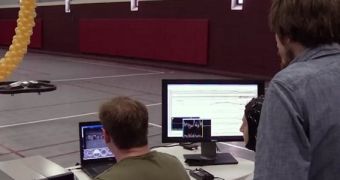Investigators at the University of Minnesota, led by biomedical engineer Bin He, are currently working on improving the design and functionality of an advanced brain-computer interface (BCI) device, which has thus far been used to control a quadcopter in mid-flight using brain impulses alone.
Generally speaking, a BCI is an array of electrodes such as those used for electroencephalography (EEG), which is able to pick up and interpret electrical signals from the human brain, and use them to control objects such as lights, electrical appliances, pointers on a computer screen, wheelchairs and, apparently, quadcopters.
The UM team is developing their BCI in hopes that it will one day be used to restore at least partial functionality to people with severe disabilities, including paralysis. The device is being developed with funding from the US National Science Foundation (NSF).
The EEG cap the team uses for the receptor part of the BCI is outfitted with a total of 64 electrodes, which are capable of picking up even minute differences in electrical activity patterns across the human brain. A piece of specialized software than interprets these signals, and sends direction instructions to the quadcopter via Wi-Fi.

 14 DAY TRIAL //
14 DAY TRIAL //